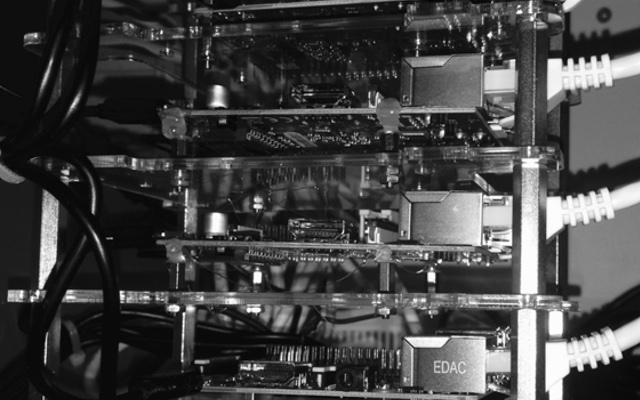
This is part 1 in a series of posts describing how I have setup Gogs and Drone on my Kubernetes-ARM cluster. Gogs - Go Git Service is A painless self-hosted Git service and is a great alternative when you can’t use GitHub or wan’t to host your own Git service.
The easiest way to get started with Gogs (and of course the only alternative if you wan’t to use Kubernetes) is to use a Docker image. Gogs has a Docker image ready on Docker Hub. Unfortunately that image won’t work on ARM. Thankfully the Hypriot team has two Gogs Docker images ready: hypriot/rpi-gogs-raspbian and hypriot/rpi-gogs-alpine
Lets try it out:
$ kubectl run my-gogs --image=hypriot/rpi-gogs-alpine --replicas=1 --port=3000
replicationcontroller "my-gogs-service" created
Here we can see our pod is running:
$ kubectl get pods
NAME READY STATUS RESTARTS AGE
my-gogs-3adh8 1/1 Running 0 1m
Now it’s time to expose our new pod as a service:
$ kubectl expose rc my-gogs --port=80 --target-port=3000 --name=my-gogs-service
service "my-gogs-service" exposed
If all went well we can now access or new service:
$ curl -s http://[master-ip]:8080/api/v1/proxy/namespaces/default/services/my-gogs-service/install|grep Version:
<p class="left" id="footer-rights">© 2015 Gogs · Version: 0.6.1.0325 Beta Page:<strong>2259ms</strong>
But oops! that´s kind of an old version. Our goal is to use Gogs together with
Drone and this won’t work. We need a version greater than 0.6.16.1022
(see). I guess this is the difference
between leading edge and bleeding edge. Again we’re saved by some one else’s
work. Gogs has a Dockerfile.rpi ready that we can use to build our own image.
I’ve built and pushed an image to Docker Hub that you can use:
larmog/rpi-gogs that is 33MB.
So lets repeat the steps above with the new image and curl for the version:
$ curl -s http://[master-ip]:8080/api/v1/proxy/namespaces/default/services/my-gogs-service/install|grep Version
© 2016 Gogs Version: 0.8.23.0126 Page: <strong>1622ms</strong> Template: <strong>1619ms</strong>
Version 0.8.23.0126, that looks so much better don’t, you think?
Next step is to install Gogs. But hey… wait a minute - what about persistence? We need to add a Volume. I’m using my home NAS, a DiskStation, over NFS. The only thing we need to do is to share a volume over NFS and install NFS on our nodes.
$ sudo apt-get -y install nfs-common
Next we need to create a PersistentVolume:
apiVersion: v1
kind: PersistentVolume
metadata:
name: pv-gogs
spec:
capacity:
storage: 5Gi
accessModes:
- ReadWriteOnce
persistentVolumeReclaimPolicy: Recycle
nfs:
path: /volume1/kbn1/gogs
server: my-nfs-server
and then a PersistentVolumeClaim:
kind: PersistentVolumeClaim
apiVersion: v1
metadata:
name: pvc-gogs
spec:
accessModes:
- ReadWriteOnce
resources:
requests:
storage: 5Gi
and lastly mount the volume in our pod template:
apiVersion: v1
kind: ReplicationController
metadata:
labels:
app: my-gogs
name: my-gogs
namespace: default
spec:
replicas: 1
selector:
app: my-gogs
template:
metadata:
labels:
app: my-gogs
spec:
containers:
- image: larmog/rpi-gogs:0.8.23.0126-2
imagePullPolicy: IfNotPresent
name: my-gogs
volumeMounts:
- mountPath: "/data"
name: persistentdata
resources: {}
ports:
- containerPort: 3000
name: web
protocol: TCP
- containerPort: 22
name: ssh
protocol: TCP
dnsPolicy: ClusterFirst
restartPolicy: Always
terminationGracePeriodSeconds: 30
volumes:
- name: persistentdata
persistentVolumeClaim:
claimName: pvc-gogs
NFS v4 is kind of hard to use if you don’t have synchronized your users and
groups in your domain. I use all_squash to a specific UID/GID in order to get
it to work with my NAS, and that works fine for Gogs but I’ve got plans to
replace NFS with GlusterFS and it’s on the TODO
list.
Let’s enjoy the fruit of our work (or as we say in Sweden: “ett Ernst ögonblick”):
$ kubectl get services
NAME CLUSTER_IP EXTERNAL_IP PORT(S) SELECTOR AGE
my-gogs-service 10.0.0.85 <none> 80/TCP app=gogs 9d
my-gogs-ssh 10.0.0.216 nodes 2222/TCP app=gogs 9d
kubernetes 10.0.0.1 <none> 443/TCP <none> 25d
Notice that I’ve also created a service for the ssh port.
Now we can complete the Gogs installation. Open the url (http://[master-ip]:8080/api/v1/proxy/namespaces/default/services/my-gogs-service)
and complete the installation.
In Part 2 I will
explain how to set up service-loadbalancer to expose your services outside your
cluster.
7 Feb 2016 #Development #Docker #Kubernetes #Raspberry PI #Gogs #Drone